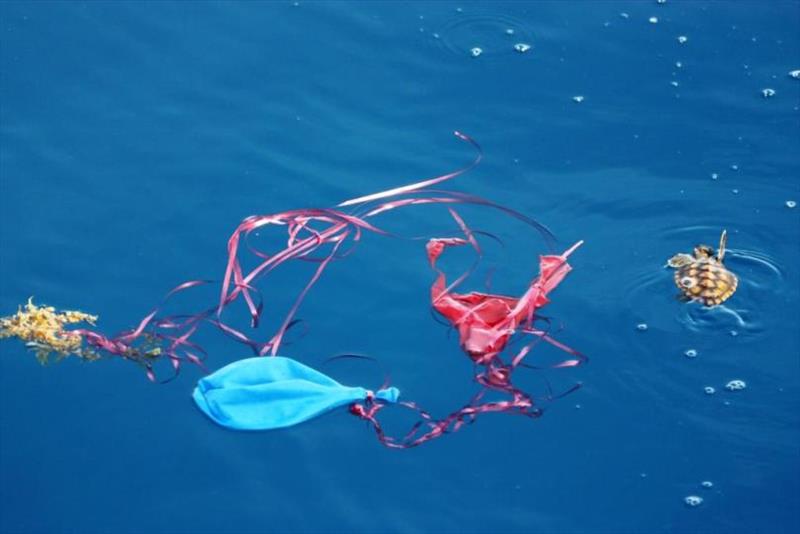
Well-meaning balloons turn into deadly trash in the water
by NOAA Fisheries 15 Jun 2018 11:20 UTC

A Loggerhead turtle hatchling swims alongside latex balloon garbage © Balloons Blow, balloonsblow.org
If you wouldn't throw a soda can out of your car window, then rethink releasing balloons. While releasing balloons have come to symbolize hopes, dreams, and good wishes for the future, every balloon released during celebrations comes down as trash, with grave potential to injure or kill wildlife.
Scott Benson, a marine ecologist with NOAA Fisheries' Southwest Fisheries Science Center, remembers fishing a balloon out of the ocean off the coast of San Francisco during a leatherback sea turtle research survey. On the balloon was a phone number. So he called.
"It went to a school in the Oakland area," Benson said. "I spoke with the teacher who released it and she was shocked that I had found it 20 to 30 miles off the coast. She told me they would never release balloons again for fear they might end up in the ocean."
We see balloons everywhere: at memorials, funerals, graduations, birthdays, anniversaries, weddings, conventions, sporting events, and even car dealerships. It can feel joyful to release them up to the sky, watching them soar unfettered into the atmosphere where they vanish into the ether. Except they don't.
Balloons can travel hundreds, sometimes thousands, of miles before landing. In 1998, a balloon released at the Olympics in Nagano, Japan, landed in Los Angeles just 49 hours later, a distance of approximately 5,300 miles.
In the oceans, balloons are pollution, another source of marine debris. Marine mammals, fish, turtles and seabirds often eat the floating deflated balloons and end up choking or starving as their bellies fill up with the plastic and Mylar. Some animals get tangled in the ribbons tied to the balloons, cutting into their skin, causing infections and, in some cases, slow death.
Sea turtles are at special risk because the balloons' form, shiny Mylar material, and vibrant colors of rubber and latex resemble their favorite food – jellyfish – when floating in the water. Balloons may clog a turtle's digestive system, leaving the animal to starve to death.
Jeff Seminoff, marine ecologist and leader of the Marine Turtle Ecology and Assessment Program at the Southwest Fisheries Science Center, has spent much of his life on the ocean researching sea turtles and doesn't mince words about his feelings towards balloons.
"I hate them," he said. "I've spent quite a lot of time offshore of central and southern California doing research on sea turtles and Mylar balloons are ubiquitous. They are the one piece of trash you see more than anything else."
The Ocean Conservancy's annual International Coastal Cleanup supports his observations. Over the last nine years the Conservancy has conducted a one day "snapshot" of balloon debris during their annual beach cleanup. From 2008 through 2016, 280,293 balloons were found in the United States, an average of 31,143 each year.
A recent research study for NOAA's Marine Debris program found that many people do not understand that all balloons, even those labeled as "environmentally friendly," can harm wildlife.
Fortunately several organizations are uniting to inform the public through campaigns and social media about the harm balloons can pose to the environment, and to offer alternatives, such as blowing soap bubbles or tossing flower petals. In Virginia, for instance, a campaign called Joyful Send-off! encourages wedding planners to consider balloon-free celebrations.
Other educational websites such as Balloons Blow....Don't Let Them Go, cite the hazards balloons pose to the environment. Some cities and counties have enacted ordinances against releasing balloons.
"The whole balloon release thing just doesn't make sense anymore," said Benson. "We're just releasing garbage into the air, harming wildlife, and contributing to ocean pollution."